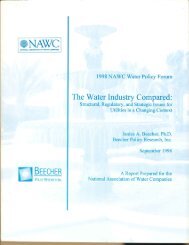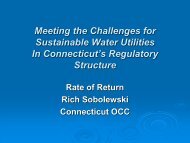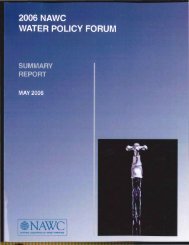Indiana University + School of Public & Environmental AffairsCenter for Urban Policy & the EnvironmentTable 1Structural Models for the Electricity IndustryElectricityIndustry StructureDefinitionAre therecompetinggenerators?Do retailers havea choice?Do finalcustomers have achoice?MonopolyMonopoly atevery levelNoNoNoPurchasing Agency WholesaleRetail CompetitionCompetitionCompetition among power generators:With single buyer Plus choice for Plus choice fordistributorsconsumersYes Yes YesNo Yes YesNo No YesSource: Hunt and Shuttleworth (1996).The water utility industry long has been considered closest to the concept of a naturalmonopoly because of the industry's high fixed costs and substantial scale economies in sourcedevelopment and treatment. Duplicating facilities for water provision would be highly inefficientand impractical.. In addition, the essential.nature of water (and wastewater) services, as well asthe substantial health, safety, and environmental issues associated with them, have reinforced thelegitimacy of the industry's monopolistic structure at the local level.For a large component of the water industry, the monopolistic nature of water utilities andthe magnitude of the capital needs to build the necessary infrastructure to provide water servicehave been used to justify public ownership. As compared with the other utility industries,municipal ownership prevails in the water sector. Many communities that own their watersystems emphasize the need to control water (and wastewater) services as a means of controllinggrowth and development through annexation. For most publicly owned water systems,government ownership substitutes both for competition and for regulation. Only about a dozenstates regulate publicly owned water systems, and usually on a limited basis. 43However, an interesting trend to watch for in the electricity area is the possibility of "municipalization," or thegreater presence of publicly owned systems in electricity markets. Public power systems could play asignificant role in a more competitive environment as purchasers of power on behalf of communities, and evenas power-pool operators. See Joseph F. Schuler, "A Champion for Public Power," Public Utilities Fortnightly134, no. 13 (July 1, 1996).4In many cases, regulation applies only when the municipality provides service outside of municipal boundaries.Even in these instances, the scope of regulation may not be as extensive for municipal as for investor-ownedsystems. See Janice A. Beecher, 1995 Inventory of Commission-Regulated Water Utilities (Indianapolis: Centerfor Urban Policy and the Environment, 1995).2
Indiana University + School of Public & Environmental AffairsCenter for Urban Policy & the EnvironmentDespite important scientific and technological advances in some areas, such as watertesting and treatment, many of the basic engineering aspects of water supply do not lendthemselves to dramatic change or innovation. Water's physical properties limit the deliverymechanisms to pipes and pumps. Available substitutes for some water uses (such as bottled waterfor drinking) generally will not meet other community needs (such as sanitation or fireprotection). Markets for water are limited by the environmental and economic barriers to waterwheeling. Mixing water from different treatment facilities sometimes can be controversialbecause of concerns about water quality, including liability for quality assurance.Nevertheless, the water industry also is experiencing forms of competition. Water utilitiesgenerally do not compete "head-to-head" for established service territories, although it can beargued that some water markets are "contestable. " 5 The competition for serving new territories ismore evident. For example, multiple utilities in proximity to an available system may bid for theacquisition. The competition for operation and maintenance contracts in the water area alsoappears to be on the rise. Competitors for contracts include utilities, as well as other serviceproviders (such as engineering firms). A more subtle, but important, form of competition isbetween public and private ownership and operations. Public and private utilities both are strivingto provide the best possible service at the lowest cost. With rising cost pressure and constraintson public-sector funding options, however, the interest in involving the private sector in providingwater services may expand.ndgAs long-standing assumptions about public utilities are challenged, so is the long-standingcommitment to ~raditional economic regulatory methods. In the wake of competition, the centralissue for regulation is whether, and when, markets provide consumer choice to a degree thatregulatory protection against the abuse of monopoly power is no longer needed. In response tocompetition in the telecommunications and energy sectors, the scope and methods of economicregulation are being altered in fundamental ways. In fact, a deregulation movement clearly isdetectable.Curiously, but somewhat disheartening, the water utility industry usually is forgotten in thedeliberations over competition and regulatory reform. According to USA Today, "The business ofproviding and selling electricity-th-e USA's one remaining monopoly industry-is being forcedinto the harsh world of competition. " 6 As one member of Congress observed, "Look, we got.through telecommunications [deregulation]. Let's tackle the last surviving monopoly."Evidently, the water industry is not on the monopoly radar screen.A federal policy bias may be behind this misconception. The federal government has hada firm hand in restructuring the telecommunications and energy sectors, through the FederalCommunications Commission (FCC) and the Federal Energy Regulatory Commission (FERC),respectively, and the Congress. No federal agency exerts economic regulatory policy over thewater industry. Absent unprecedented and unanticipated federal intervention, state regulators will5In other words, new entrants might be able to compete for a share of the economic activity once dominatedexclusively by a vertically integrated utility6USA Today, July 16, 1996, lB.3
















